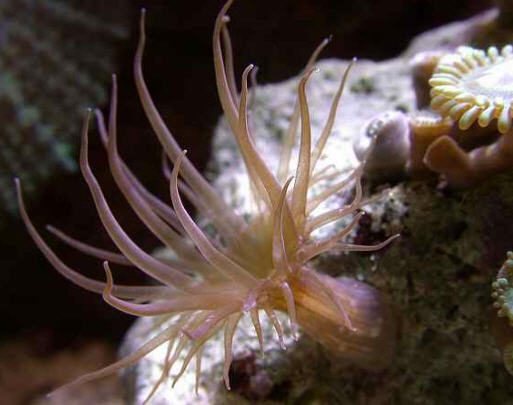Lettuce Nudibranchs (Elysia crispata) are enchanting creatures that captivate marine enthusiasts with their vibrant colors and unique feeding habits. In this in-depth guide, we’ll uncover the fascinating characteristics of Lettuce Nudibranchs, their care requirements, habitat preferences, potential challenges, and tips for successfully keeping them in a marine aquarium environment.

Understanding Lettuce Nudibranchs:
- Appearance: Lettuce Nudibranchs are renowned for their striking appearance, featuring a leaf-like body structure with intricate patterns and bright green coloration resembling lettuce leaves. Their delicate appearance makes them a favorite among aquarists seeking visually captivating marine life additions. Additionally, their bodies are typically around 2 inches long, with varying leaf patterns that contribute to their overall camouflage in reef environments.
- Feeding Behavior: Unlike typical nudibranchs that primarily feed on sponges or algae, Lettuce Nudibranchs exhibit a fascinating adaptation known as kleptoplasty. They consume algae and incorporate chloroplasts into their tissues, allowing them to photosynthesize and derive energy from sunlight, similar to plants. This unique feeding behavior sets them apart and adds an element of intrigue to their care requirements. Lettuce Nudibranchs can often be found grazing on various types of macroalgae, such as Ulva, Caulerpa, and Halimeda, in their natural habitats.
- Habitat Preferences: Lettuce Nudibranchs are commonly found in tropical and subtropical waters, inhabiting shallow reef areas with ample sunlight exposure. They prefer environments rich in algae, which serve as their primary food source and contribute to their vibrant green coloration. In aquarium settings, replicating their natural habitat with live rock structures, macroalgae growth, and moderate water flow can enhance their well-being and natural behavior.
- Tank Requirements: To successfully keep Lettuce Nudibranchs in a marine aquarium, provide a well-established reef tank with stable water parameters. Ensure adequate lighting, as these nudibranchs rely on photosynthesis for energy production. Maintain excellent water quality, including proper filtration and regular water changes, to support their health and well-being. Additionally, maintain a suitable temperature range of 72-78°F and a salinity level of 1.023-1.025 sg to mimic their natural marine habitat conditions.
Care Tips for Lettuce Nudibranchs:

- Algae Supply: Offer a varied diet of algae species suitable for Lettuce Nudibranchs, including Ulva, Caulerpa, and Chaetomorpha. Supplement their diet with commercial marine herbivore foods to ensure nutritional balance and optimal health. Providing a mix of live and dried macroalgae can stimulate their feeding behavior and provide essential nutrients.
- Lighting: Provide moderate to high-intensity lighting to simulate natural sunlight conditions for Lettuce Nudibranchs. Use LED fixtures with adjustable spectrums to promote photosynthesis and chloroplast activity within their tissues. A light spectrum with a wavelength range of 400-700 nm is ideal for supporting photosynthesis and maintaining vibrant coloration in these nudibranchs.
- Water Parameters: Maintain stable water parameters, including temperature (72-78°F), salinity (1.023-1.025 sg), pH (8.0-8.4), alkalinity (8-12 dKH), and calcium (400-450 ppm). Regularly test water quality and monitor nutrient levels to prevent algae overgrowth and maintain a healthy ecosystem. Maintaining proper water circulation and oxygenation levels is crucial for ensuring the well-being of Lettuce Nudibranchs and other tank inhabitants.
- Tankmates: Exercise caution when selecting tankmates for Lettuce Nudibranchs, as they may be vulnerable to aggressive fish or invertebrates that may view them as prey. Choose peaceful community species that won’t harass or compete with the nudibranchs for food or space. Compatible tankmates may include small, peaceful reef fish, snails, and hermit crabs that pose no threat to these delicate creatures.
Challenges and Considerations:
- Predation Risk: Lettuce Nudibranchs are susceptible to predation by certain fish species, especially those with a penchant for consuming invertebrates. Avoid housing them with aggressive or predatory species to minimize predation risk. Providing ample hiding places and sheltered areas within the aquarium can also reduce stress and predation threats.
- Algae Management: While Lettuce Nudibranchs help control algae growth in marine aquariums, ensure adequate algae supply to sustain their nutritional needs. Monitor algae levels and supplement as needed to prevent nutrient deficiencies. Avoid overfeeding to maintain water quality and prevent algae overgrowth, which can lead to nutrient imbalances and potential health issues.
- Acclimation: When introducing Lettuce Nudibranchs to a new aquarium, acclimate them slowly to avoid stress and ensure a smooth transition. Use drip acclimation methods to gradually adjust water parameters and temperature over several hours. Provide a peaceful and stress-free environment with suitable hiding spots and natural substrate materials to support their adjustment and well-being.
Conclusion:
Lettuce Nudibranchs offer a captivating glimpse into the intricate interactions between marine life and photosynthetic processes. By understanding their unique feeding habits, habitat requirements, and potential challenges, aquarists can create a suitable environment for these mesmerizing creatures to thrive. With proper care, Lettuce Nudibranchs can contribute to a vibrant and balanced marine ecosystem within the confines of a well-maintained reef aquarium.




